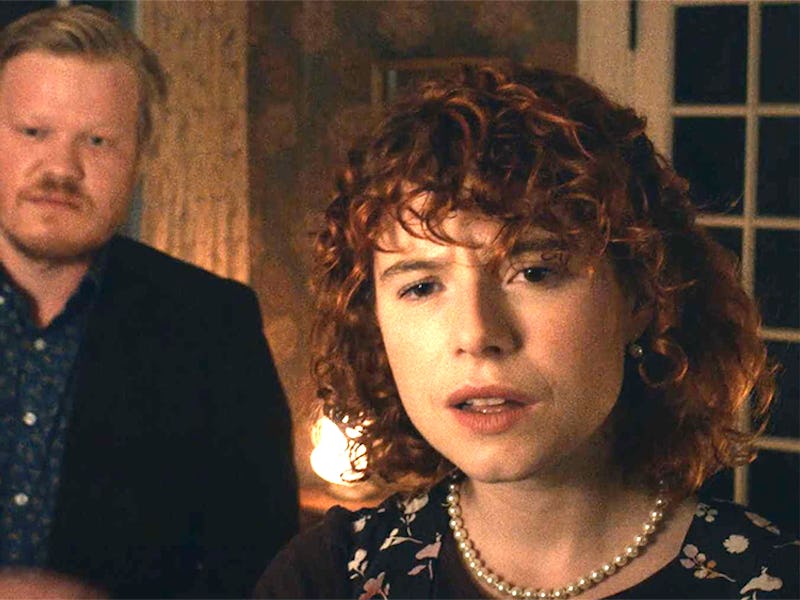I'm Thinking of Ending Things' confusing ending, explained
Wait....what exactly happened?

Explaining the ending of a Charlie Kaufman film is about as easy as explaining quantum physics. His two previous directorial works (Synecdoche, New York and Anomalisa) were subject to much speculation about what his true intent could have been, and that's what makes them so great. But I'm Thinking of Ending Things makes those movies look simple by comparison.
If you've finished Kaufman's latest film (streaming now on Netflix) and are still utterly lost, there is some help in the form of the film's source material and main inspiration: the 2016 novel of the same name by Iain Reid.
Warning! Major spoilers for I'm Thinking of Ending Things ahead.
I'm Thinking of Ending Things the film ends the same way many musicals end: a big passionate closing number. The song, "Lonely Room," is from Oklahoma!, the musical discussed and depicted in multiple scenes. However, movie fans won't recognize it, as it was omitted from its film adaptations. It's the song Jud, the villain of Oklahoma! sings as he realizes how lonely he truly is.
It's a beautiful song, with lyrics specifically referencing dreaming of being with a woman but waking up disappointed he's all alone, but Jake singing it doesn't exactly provide a satisfying ending. The actual satisfying ending goes by almost unnoticed minutes earlier.
Jake faces the audience in the last scene of the movie.
When the film's protagonist, known by many names but credited as "The Young Woman," finds herself trapped in an abandoned high school, face to face with the janitor seen in random scenes throughout the film. She asks him if he's seen her boyfriend, and when the janitor asks her to describe him, she finally speaks what sounds like the truth.
"He was a creeper, you know?" The Young Woman says, her vocal tone completely shifting. "I can't remember what he looks like. Why would I? Nothing happened. Just one of thousands of such non-interactions in my life. It's like asking me to describe a mosquito that bit me 40 years ago!"
This realization that The Young Woman is merely a woman Jake saw at a bar occurs differently in the original novel. The narrator is given one of Jake's paintings by his mother, assuring her it's a portrait of her "for later." She forgets about it until she's trapped in the high school, and upon opening it, it's clear the portrait is of Jake. This is a different ending, but more explicitly says what Kaufman implies: the entire film is Jake's delusion.
That janitor shown in various scenes over the course of the film is actually Jake's true self, who daydreams and has delusions of a life where he is younger and has a girlfriend who is whoever he wants her to be, be it a poet, a physicist, a film critic. The Young Woman exists, yes, but the version we see in the film is entirely fictional, just a woman he saw at a bar once.
Dream versions of Jake and The Young Woman dance in the high school hallway.
The movie instead uses the language of musical theater to spell out its ending. Moments after her conversation with the janitor, she finds herself finally reunited with Jake when they are joined by identically dressed doppelgangers (perhaps a nod to Synecdoche, New York). These lookalikes start dancing to the film's score, playing off each other in a haunting pas de deux.
This dance encapsulates the entirety of Jake/the janitor's delusion. Dream Jake and his Dream Girlfriend meet, fall in love, get engaged, and get married, only for a Dream Janitor to try and steal the girlfriend away. Jake and the Janitor fight, and the Janitor stabs and kills Jake, taking the girlfriend for himself. The conflict between Jake and the Janitor could be interpreted as his true self fighting his delusional self, spurring on the ending of the movie and thus the ending of the film.
This use of dance is what's known in the musical theatre community as a dream ballet, where a character has a dream portrayed by a ballet sequence where all characters are played by professional ballet dancers. This technique has been used in multiple musicals, but it originated in, of course, Oklahoma!. This dream sequence, combined with the later song about dreaming of love, makes the tragic conclusion a bit more obvious.
Charlie Kaufman never seems to be content using just cinematic language to get his point across, and while the film's version of the ending may require some homework to decode, that's just the joy of his work: the way it can be manipulated and re-evaluated from a cinematic angle, a theatric angle, and a literary angle.
I'm Thinking of Ending Things is now streaming on Netflix.
This article was originally published on